Sentiment Analysis: Definition, Importance, Indicator Types, Benefits, and Examples
Understanding the prevailing mood in financial markets is crucial for successful trading. Sentiment analysis provides valuable insights into the mindset of traders and investors, helping you make informed decisions. This comprehensive guide, brought to you by Plexytrade, explores the definition, importance, types of indicators, benefits, and practical examples of sentiment analysis across various financial instruments, including stocks, indices, forex, and cryptocurrencies.
What is Sentiment Analysis?
Sentiment analysis is like taking the pulse of the financial markets. It’s about understanding the collective emotions, opinions, and intentions of traders and investors. Instead of just looking at price charts and technical indicators, sentiment analysis explores the conversations happening online – in news articles, social media posts, blog comments, and forums – to measure the overall mood.
This is where the magic of technology comes in. Natural Language Processing (NLP) helps computers understand human language. It allows them to sift through mountains of text and analyze the underlying sentiment. Are people feeling optimistic and greedy? Or are they fearful and uncertain?
By understanding these emotions, traders can gain a valuable edge. They can anticipate market shifts, confirm their trading ideas, and make smarter decisions
What is the Importance of Sentiment Analysis?
Sentiment analysis gives traders a powerful edge by offering a view of the market that they simply couldn’t get on their own. It’s like having access to the collective wisdom of the crowd.
Imagine trying to keep track of every news, article, social media post, and online discussion about a particular asset. It would be impossible! But sentiment analysis tools can do this for you, aggregating vast amounts of information and distilling it into actionable insights.
Are traders feeling confident and bullish? Or are they nervous and bearish? This “big picture” view helps traders understand the underlying forces driving the market.
What are the Indicator Types for Sentiment Analysis?
While there are many indicators that can provide insights into market sentiment, here are some of the most popular ones:
1. Volatility Index (VIX): Often called the “fear gauge,” the VIX measures market volatility. A high VIX suggests that investors are nervous and expect big price swings, while a low VIX indicates a calmer market.
2. Bullish Percent Index (BPI): The BPI tracks the percentage of stocks showing bullish price patterns. A high BPI suggests optimism, while a low BPI indicates pessimism.
3. Moving Averages (MA): Moving averages smooth out price data to reveal trends. A rising moving average suggests an uptrend, while a falling one indicates a downtrend. Crossovers of different moving averages can also signal potential trend changes.
- Simple Moving Average (SMA): Calculates the average price over a specific period.
- Exponential Moving Average (EMA): Gives more weight to recent prices, making it more sensitive to short-term changes.
4. High-Low Index: This index compares the current price to the 52-week high and low, and can help identify overbought or oversold conditions.
Plexytrade allows traders to easily manage their transactions on the most well-known platforms such as MetaTrader 4 and MetaTrader 5. Traders can easily incorporate these technical indicators into their trading strategies to gain a deeper understanding of market sentiment and make more informed trading decisions. Remember to combine these indicators with other forms of analysis, such as news sentiment and social media sentiment, for a complete picture of the market.
What Are the Benefits of Sentiment Analysis in The Stock Market?
Sentiment analysis is quickly becoming a must-have tool for smart investors. While traditional technical analysis focuses on numbers and charts, sentiment analysis adds another layer of insight by revealing the emotions and opinions driving the market.
Uncover Hidden Trends: Sentiment analysis can help you identify market trends that might not be obvious from price charts alone. By understanding the mood of the market, you can anticipate shifts in direction and make better-informed trading decisions. Sentiment analysis can help you avoid being fooled by misleading price movements. For example, if everyone is overly optimistic about a particular stock, sentiment analysis might reveal that it’s overvalued and due for a correction.
Plexytrade provides its traders with the tools and resources they need to harness the power of sentiment analysis. By combining sentiment data with technical analysis and sound risk management practices, you can significantly enhance your trading performance.
What are Some Examples of Sentiment Analysis?
The “Taking Tesla Private” Tweet:
In 2018, Musk tweeted about taking Tesla private, sending shockwaves through the market. Investors reacted quickly, driving up Tesla’s stock price as they anticipated the potential benefits of this move.
This event highlighted the power of social media sentiment to influence market trends. Traders who were able to analyze the sentiment around Musk’s tweets could have capitalized on this opportunity.
Sentiment Analysis in Action:
Today, sophisticated tools can track and analyze the sentiment expressed in Elon Musk’s tweets (and those of other influential figures). This provides valuable insights into the market mood and potential price movements.
On the other hand, while social media sentiment can be a powerful indicator, it’s important to remember that it’s just one piece of the puzzle. Always combine sentiment analysis with other forms of market analysis, such as technical indicators and fundamental research, for a complete picture.
How Does Sentiment Analysis Work?
Sentiment analysis isn’t just about guessing how people feel. It’s a systematic process that involves several key steps:
1. Gather the Data: First, we collect a vast amount of information from news articles, social media posts, blog comments, forum discussions, and more.
2. Analyze the Data: Next, we use advanced technology, like Natural Language Processing (NLP), to analyze the collected data, which helps us understand the emotions and opinions expressed in the text.
3. Find the Patterns: We then compare the current sentiment with historical data. How have people’s opinions changed over time? How did those changes correlate with past market movements? This helps us identify patterns and trends.
4. Draw Conclusions: Finally, we combine our sentiment analysis with other market indicators, like price charts and trading volume. This allows us to form a complete picture of the market and make informed predictions about future trends.
What Are the Key Sources of Data Used for Stock Market Sentiment Analysis?
Sentiment analysis relies on gathering information from where people express their opinions and emotions. Two key sources are particularly valuable:
1. The Web: News articles, blogs, and financial websites provide a wealth of information about market sentiment. Experts share their analyses, companies release announcements, and overall discussions shape the narrative around different assets.
2. Social Media: Platforms like Twitter, Facebook, and StockTwits have become hotbeds for sharing market opinions. Traders and investors express their views in real-time, creating a constant stream of sentiment data.
This can be particularly impactful when influential figures weigh in. Remember Elon Musk’s tweets about Dogecoin? His comments sparked a surge of interest in cryptocurrency, illustrating how social media sentiment can dramatically influence market trends.
What Are the Popular Techniques Used in Stock Market Sentiment Analysis?
Sentiment analysis uses powerful technologies to understand the human emotions and opinions that influence financial markets. Here are some of the key techniques involved:
1. Natural Language Processing (NLP): NLP helps computers understand human language. It allows them to read and interpret text, identify patterns, and extract meaning from words and sentences. This is crucial for analyzing news articles, social media posts, and other text-based sources of sentiment data.
2. Advanced NLP with Deep Learning: Deep learning takes NLP to the next level. It uses sophisticated algorithms to understand the nuances of language, including context, word order, and even sarcasm. This allows for more accurate sentiment analysis, especially in complex or ambiguous situations.
3. Sentiment Lexicons: These are dictionaries that categorize words as positive, negative, or neutral. NLP tools use these lexicons to analyze the overall sentiment expressed in a piece of text.
4. Machine Learning (ML): ML algorithms can learn from data and improve their accuracy over time. In sentiment analysis, ML can be used to identify patterns and correlations between sentiment data and market movements. This can help predict future trends and identify trading opportunities.
- Supervised Learning: This involves training ML models on labeled data, where the sentiment is already known.
- Unsupervised Learning: This allows ML models to discover patterns and insights in unlabeled data, potentially revealing new sentiment indicators.
What Are the Challenges of Sentiment Analysis in The Stock Market?
While sentiment analysis is a powerful tool, it’s important to be aware of its limitations. Here are some challenges to keep in mind:
- Subjectivity and Misinterpretation: Human language can be complex and nuanced. Sarcasm, irony, and ambiguous wording can be difficult for sentiment analysis tools to interpret accurately. This can lead to misleading results, especially when analyzing social media posts or informal online discussions.
- Intentional Manipulation: Sometimes, people intentionally spread misinformation or manipulate sentiment to influence market prices. This can create artificial sentiment signals and lead to poor trading decisions. For example, a false rumor spread on social media can cause a stock’s price to surge or plummet, even if there’s no real basis for the movement.
- Evolving Language: The language used in online discussions is constantly changing. New slang, abbreviations, and emojis can emerge quickly, making it challenging for sentiment analysis tools to keep up. This can lead to misinterpretations and inaccurate sentiment readings.
It’s important to remember that sentiment analysis is just one tool in a trader’s arsenal. Always combine sentiment data with other forms of market analysis and exercise caution when making trading decisions.
How Can Sentiment Analysis Help Identify Market Indicators?
Think of technical analysis as the “what” of market analysis. It looks at price charts, trading volume, and other quantifiable data to understand what has happened in the market.
Sentiment analysis, on the other hand, is the “why.” It delves into the psychological and emotional drivers behind market movements. Why are traders buying or selling? What are their expectations and fears?
By combining these two perspectives, traders can gain a much richer understanding of the market. Technical analysis provides objective facts, while sentiment analysis adds subjective context. This holistic view can lead to more informed trading decisions.
For example, imagine a stock that has been steadily rising. Technical analysis might suggest that the uptrend is likely to continue. However, if sentiment analysis reveals growing pessimism among traders, it could signal a potential reversal. This insight allows traders to anticipate potential risks and adjust their strategies accordingly.
Frequently Asked Questions
Q: How reliable is sentiment analysis for predicting market movements?
A: While sentiment analysis can’t predict the future with 100% accuracy, it can be a valuable tool for understanding market trends and making informed trading decisions. For the best results, combine sentiment data with other forms of analysis, such as technical indicators and fundamental research.
Q: Can individual traders use sentiment analysis?
A: Absolutely! Plexytrade provides its traders with the tools and resources they need to conduct sentiment analysis. We offer educational materials, advanced trading platforms, and access to sentiment data feeds through the economic calendar.
Q: How often should I analyze market sentiment?
A: Market sentiment can change quickly, so it’s important to stay updated. If you’re an active trader, consider monitoring sentiment regularly, even multiple times a day.
Q: Do all markets react the same way to sentiment indicators?
A: Not necessarily. Different markets have unique characteristics and can respond differently to sentiment signals. It’s important to understand the specific dynamics of each market you trade-in.
Q: Can sentiment analysis replace traditional financial analysis?
A: No. Sentiment analysis is most effective when used in conjunction with traditional financial analysis methods. By combining different perspectives, you can gain a more complete understanding of the market and make better-informed trading decisions.















